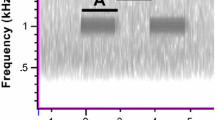Abstract
The field cricket species, Gryllus firmusand G. pennsylvanicus,occur in a mosaic hybrid zone that roughly parallels the eastern slope of the Appalachian mountains in the northeastern United States. It is important to know what role, if any, the calling song plays in mate choice in sympatric and allopatric populations. In this report, we present results on the variability of calling song properties along transects across this hybrid zone. We also present the results of experiments on phonotactic selectivity of females from an allopatric population of G. firmus.The male calling song of allopatric G. firmuswas significantly slower in temporal rhythm (i. e., chirp and pulse repetition rates) and lower in pitch (i.e., dominant frequency) than that of allopatric G. pennsylvanicus.Calling song properties of males recorded in the hybrid zone varied considerably in temporal and spectral properties. In two-stimulus (choice) phonotaxis experiments, allopatric females of G. firmuspreferred synthetic calling songs with conspecific pulse repetition rates over songs that had lower and higher pulse rates. This preference persisted even when the sound pressure levels of alternative stimuli were unequal. Therefore, allopatric females of G. firmuscan discriminate between conspecific and heterospecific calling songs. Whether or not this same selectivity is present in sympatric populations remains unclear. Investigations of phonotactic selectivity in other allopatric and sympatric populations of both species are currently under way.
Similar content being viewed by others
References
Alexander, R. D. (1957). The taxonomy of the field crickets of the eastern United States (Orthoptera: Gryllidae:Acheta).Ann. Entomol. Soc. Am. 50: 584–602.
Alexander, R. D. (1968). Life cycle origins, speciation, and related phenomena in crickets.Q. Rev. Biol. 43(1): 1–41.
Alexander, R. D., and Meral, G. (1962). Seasonal and daily chirping cycles in the northern spring and fall crickets,Gryllus veletis andG. pennsylvanicus.Ohio J. Sci. 67: 200–209.
Batschelet, E. (1981).Circular Statistics in Biology, Academic Press, New York.
Bentley, D. R., and Hoy, R. R. (1972). Genetic control of the neuronal network generating cricket (Teleogryllus, Gryllus) song patterns.Anim. Behav. 20: 478–492.
Doherty, J. A. (1985). Phonotaxis in the cricket,Gryllus bimaculatus De Geer: Comparisons of choice and no-choice paradigms.J. Comp. Physiol. A. 157: 279–289.
Doherty, J. A. (1990). A program for analyzing temporal pattern intervals in repetitive, animal sounds.Behav. Res. Meth. Instrum. Comput. 22(5): 477–485.
Doherty, J. A. (1991). Song recognition and localization in the phonotaxis behavior of the field cricket,Gryllus bimaculatus (Orthoptera: Gryllidae).J. Comp. Physiol. A 168: 213–222.
Doherty, J. A., and Callos, J. D. (1991). Acoustic communication in the trilling field cricket,Gryllus rubens (Orthoptera: Gryllidae).J. Insect Behav. 4: 67–82.
Doherty, J. A., and Pires, A. (1987). A new microcomputer-based method for measuring walking phonotaxis in field crickets (Gryllidae).J. Expt. Biol. 130: 425–432.
Gerhardt, H. C., and Doherty, J. A. 1988. Acoustic communication in the gray treefrog,Hyla versicolor. Evolutionary and neurobiological implications.J. Comp. Physiol. 162: 261–278.
Harrison, R. G. (1979). Speciation in North American field crickets: Evidence from electrophoretic comparisons.Evolution 33(4): 1009–1023.
Harrison, R. G. (1983). Barriers to gene exchange between closely related cricket species.1. Laboratory hybridization studies.Evolution 37(2): 245–251.
Harrison, R. G. (1985). Barriers to gene exchange between closely related cricket species. 2. Life cycle variation and temporal isolation.Evolution 39(2): 244–259.
Harrison, R. G. (1986). Pattern and process in a narrow hybrid zone.Heredity 56(3): 337–349.
Harrison, R. G., and Arnold, J. (1982). A narrow hybrid zone between closely related cricket species.Evolution 36(3): 535–552.
Harrison, R. G., and Rand, D. M. (1989). Mosaic hybrid zones and the nature of species boundaries. In Otte, D., and Endler, J. A. (eds.),Speciation and Its Consequences, Sinauer, Sunderland, MA, pp. 111–133.
Harrison, R. G., Rand, D. M., and Wheeler, W. C. (1987). Mitochondrial dna variation in field crickets across a narrow hybrid zone.Mol. Biol. Evol. 4(2): 144–158.
Rand, D. M. and Harrison, R. G. (1989). Ecological genetics of a mosaic hybrid zone: Mitochondrial, nuclear, and reproductive differentiation of crickets by soil type.Evolution 43(2): 432–449.
Schmidt-Koenig, K. (1975).Migration and Homing in Animals, Springer, New York.
Author information
Authors and Affiliations
Rights and permissions
About this article
Cite this article
Doherty, J.A., Storz, M.M. Calling song and selective phonotaxis in the field crickets,Gryllus firmus andG. pennsylvanicus (Orthoptera: Gryllidae). J Insect Behav 5, 555–569 (1992). https://doi.org/10.1007/BF01048004
Accepted:
Issue Date:
DOI: https://doi.org/10.1007/BF01048004




